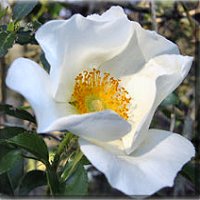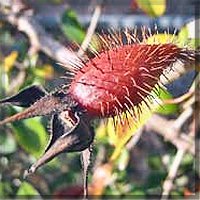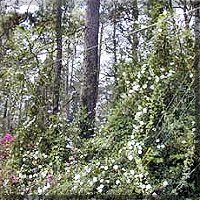


Rosa laevigata



Rosa
laevigata
Other Names - Camellia Rose, Mardan Rose, Jin ying zi
Description - This evergreen climbing rose produces long, thorny, vinelike canes that will form a mound 10-12 ft (3-3.7 m) in height and about 15 ft (4.6 m) wide. This rose is often seen sprawling across adjacent shrubs and other supports that it employs to climb to even greater heights. The pure white single flowers are 3.5-4 in (9-10 cm) in diameter and appear in spring. They are densely arranged along the length of the canes that form garlands of blossoms. The fruit of the Cherokee rose is called a hip and is large compared to other members of the rose family being 1.5-2 in (4-5 cm)long by 0.5-1 in (1-2.5 cm) wide. Cherokee rose has attractive evergreen compound leaves composed of three leaflets with the center leaflet larger than its partners. The glossy light green leaflets are oval shaped with a pointed tip and range from 1-3.5 in (2.5-9 cm)long and 1-2 in (2.5-5 cm) wide.
The Cherokee rose's fast growth rate and long stems armed with large hooked thorns make it an effective screening and barrier plant. It's a useful addition to natural areas where it will shoot long arching stems that will string themselves vinelike through tree branches and shrubs. Grow on trellises, fences or tree trunks or plant in an open area where it will grow into a large mound. Rather than trim the plant into a mound, let the canes grow long so they can weave white springtime garlands through adjacent shrubbery. Cherokee rose is very happy in waterside situations where it can cast shimmering reflections upon still surfaces.In 1838-39, the rose became symbolic of the genocide called the Trail of Tears. By legend, the rose was said to spring from the tears of mothers unable to save their children during the forced winter march. In reality, the reliable Cherokee rose was sold through southern nurseries shortly before and after the Civil War. In Alabama's 'Black Belt', the counties with the deepest, most productive soils, the rose only furthered the abject poverty. It colonized hundreds of acres rendering the land useless for crops and pasture.
Blooming period for this species is at its best during the last ten days of March and the first ten days of April, but a second bloom may occur in fall if properly cultivated." The jin ying zi blooms about the same time in Florida. The root bark contains tannin, and is used for tanning. Sugar is extracted from the fruit, which is also used to ferment wine. The roots, leaves, and fruit are all used medicinallyEdible Uses - Fruit (raw or cooked). The pear-shaped fruit is up to 4cm long, but there is only a thin layer of flesh with seed hairs surrounding the many seeds. Each hip comprises an outer fleshy layer, the hypanthium, which contains 5–160 "seeds" (technically dry single-seeded fruits called achenes) embedded in a matrix of fine, but stiff, hairs. Some care has to be taken in that the hairs must first be removed before eating this fruit. The seed is a good source of vitamin E, it can be ground and mixed with flour or added to other foods as a supplement. The hips were much eaten in Europe, cooked with meats, made into tarts & cookies, jams, jellies & preserves, and were fermented into wine in Russia. The leaves have been used as a fragrant tea.
Pharmacology - Laevigatanoside A (2 alpha, 3 beta, 19 alpha, 23-trihydroxy-12-ursorlic-28-glucopyester) was isolated from the fruits of Rosa laevigata. It is rich in vitamin C (60 times concentration of lemons), saponin glycosides ~17%, flavonoids, carotenoids, leucoanthocyanidins, catechins and plant acids many of which have strong antioxidant properties.
Medicinal Use - The leaves are a famous vulnerary. The fruits, root and leaves are emmenagogue and depurative. Their use stabilizes the kidneys. A decoction is used in the treatment of chronic dysentery, urinary tract infections, wet dreams, prolapse of the uterus, menstrual irregularities and traumatic injuries. The root bark is astringent and used in the treatment of diarrhoea and menorrhagia. The dried fruits are antibacterial, anticholesterolemic, astringent, carminative, diuretic and stomachic. They are used internally in the treatment of urinary dysfunction, infertility, seminal emissions, urorrhoea, leucorrhoea and chronic diarrhoea. The root is used in the treatment of uteral prolapse. The flowers are used in the treatment of dysentery and to restore hair cover. The fruit of many members of this genus is a very rich source of vitamins and minerals, especially in vitamins A, C and E, flavanoids and other bio-active compounds. It is also a fairly good source of essential fatty acids, which is fairly unusual for a fruit. It is being investigated as a food that is capable of reducing the incidence of cancer and also as a means of halting or reversing the growth of cancers.
Dosage - A decoction is typically made with 6-12g of Fructus Rosae Laevigatae with three to four cups of boiling water until the volume is reduced by half. The decoction is usually taken orally and split into two doses in the course of the day.
Rose hip tea: Long served in northern Europe. Very high in vitamin C and good for daily use. The dried, finely chopped rose hips must be soaked in a small amount of water for 12 hours before using. The tea is made by simmering 1 tbsp. rosehips in 3 cups of water for 30-40 minutes. A small amount of dried hibiscus flowers makes a nice addition to this tea, giving it a lemony flavor and a very attractive burgundy color.
Contraindications - Caution - (Fruit ) There is a layer of hairs around the Cherokee Rose seeds just beneath the flesh of the fruit. These hairs can cause irritation to the mouth and digestive tract if ingested. Stems of Plant also have thorns and are irritants.